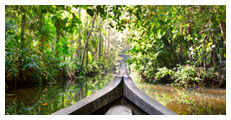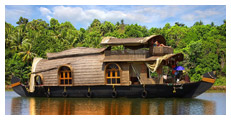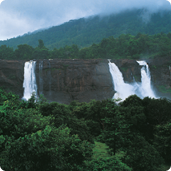About Kerala
-

Hotels
Here we give you information about the different type of Hotels in Kerala which we have used in the past...
Read More...
-

Itinerary
Various tour itineraries are there in our offerings which includes tours and trips to various parts of South India...
Read More...
-

Cities
Trivandrum, Pathanamthitta, Alappuzha, Kottayam, Idukki, Munnar, Periyar, Eranakulam, Kollam...
Read More...
-

Beaches
Kerala, a state situated on the tropical Malabar Coast of southwestern India, is one of the most popular tourist destinations...
Read More...
-

Prime Attraction
Kerala offers 226 cultural attractions, including Temples, monuments, beaches, cities attractions, churches, etc ...
Read More...
-

House Boats
The trip on a house boat through the canals and rivers of the hinterland is probably the most relaxed and intense...
Read More...
GODS OWN COUNTRY

Sandwiched between the Lakshwadeep Sea and the Western Ghats, Kerala is a bustling little green-and-silver, coconuts-and-water state on the west coast of India. It is bounded by Karnataka to the north, Tamil Nadu to the east, and the Arabian Sea to the west. Thiruvananthapuram is its capital.
Every district in Kerala has it's own unique culture and characteristics. Thiruvananthapuram is known for it's beach- Kovalam, the Sri Padmanabhaswamy Temple and various museums and palaces; Alappuzha for it's backwaters, Thrissur, the cultural capital, Kottayam for it's ancient churches, Kozhikode for it's old world charm and the entrancing Ponmudi or Golden valley.
-
Capital of Kerala
Though a bit of a tongue-twister, Thiruvananthapuram - the present official name, is closer to it's mythological origins. The word ' Thiru ananthapuram' means the city of Anantha or the abode of the sacred thousand-headed serpent Anantha, who forms the couch on which reclines Lord Vishnu, the preserver in the Hindu trinity.
Built on seven hills, it was the capital of the Venad chieftains. The city has grown as a tourist and commercial centre, with the International airport becoming the main gateway into Kerala. Being the state capital, it also throbs with political activity.
-
History of Kerala
Original inhabitants were animists, followed by the Dravidians. After Alexander's triumphant sweep over Asia Minor, the ports of Kerala became a link between the Middle East, the Mediterranean and China.
In 1498, Vasco da Gama made his historic landing on the Malabar Coast. In 1723, the East India Company signed a strategic treaty with King Marthanda Varma. For a few decades, Hyder Ali and his son -Tipu sultan proved to be a thorn in the flesh of the British, sweeping down several times into Kerala. In 1947, it was the turn of the British to pack their bags.
-
The People
Kerala also has considerable ethnic diversity. The Malayali majority belong to the Dravidian group (local race) of early Indian peoples.
There is a small population of descendants of Indo-European migrants from the north. Certain hill tribes exhibit affinities with the Negrito peoples of Southeast Asia. Most Keralites are Hindus, but there are also large Christian and Islamic, and lesser Jain and Jewish, minorities.
The official language is Malayalam. A long contact with the outside world has led to an intriguing blend of cultures and given Keralites a cosmopolitan outlook
-
Culture of Kerala

One aspect of the state's rich cultural heritage is manifest in its varieties of religious architecture: ancient Hindu temples with copper-clad roofs, later Islamic mosques with "Malabar gables," and colonial Portuguese Baroque churches.
Splendid paintings, especially murals, exhibit distinct local traditions and styles. The land is a flourishing center of the Kathakali dance form. The state has also a rich theatre tradition: the only surviving Sanskrit drama, Koottiyattam, is still performed by the Chakkiars of Kerala. Some principles of the Natya-Shastra are evident in their presentations.
-
Occupation in Kerala
Agriculture is the state's main economic activity. Plantations of cardamom, cashew nut, coconuts, coffee, ginger, pepper, rubber, and tea account for 40 percent of the total land.
Commercial poultry farming is well developed. Cottage industries--for example, the processing of coconut fibre and cashews or weaving--employ about three-fifths of Kerala's industrial workers. Most of those employed by larger industrial enterprises are engaged in food and textile processing.
-
Climate in Kerala
The climate is equable and varies little from season to season. The temperature normally ranges between 27º and 32º C in the plains but drops to about 21º C in the highlands.
Winter - 32 to 20 º C. Kerala is strongly buffeted by both the southwest and northeast monsoons. Rainfall in many parts of the state exceeds 118 inches. Best season: October to March.
-
Population of Kerala
-
Festivals of Kerala
10-day annual festival in January at Sreekandeswaram Temple, Thiruvananthapuram. In February, is the week-long Nishagandhi Dance festival; Pooram festival in Thrissur around April-May; Flavor Food Festival, at the Kanakakunnu Palace grounds, Thiruvananthapuram in May.
Onam Week celebrations, the annual harvest festival of Kerala begins in August and lasts for 10 days. Another important festival is the annual Pongala Utsavam, to which only women are allowed at the Attukal Bhagavathy Temple, Thiruvananthapuram. Therayattam festival is held to propitiate the gods and demons recognized by the pantheon of the Malayalis.
-
Tourist Offices in Kerala
Tourist Reception Centre In front of Kerala Tourism Development Corporation (KTDC) Chaithram hotel, Thiruvananthapuram, near Rly stn.
Tourist Facilitation Centre Museum Rd, Thiruvananthapuram, opp. Museum and zoo.









